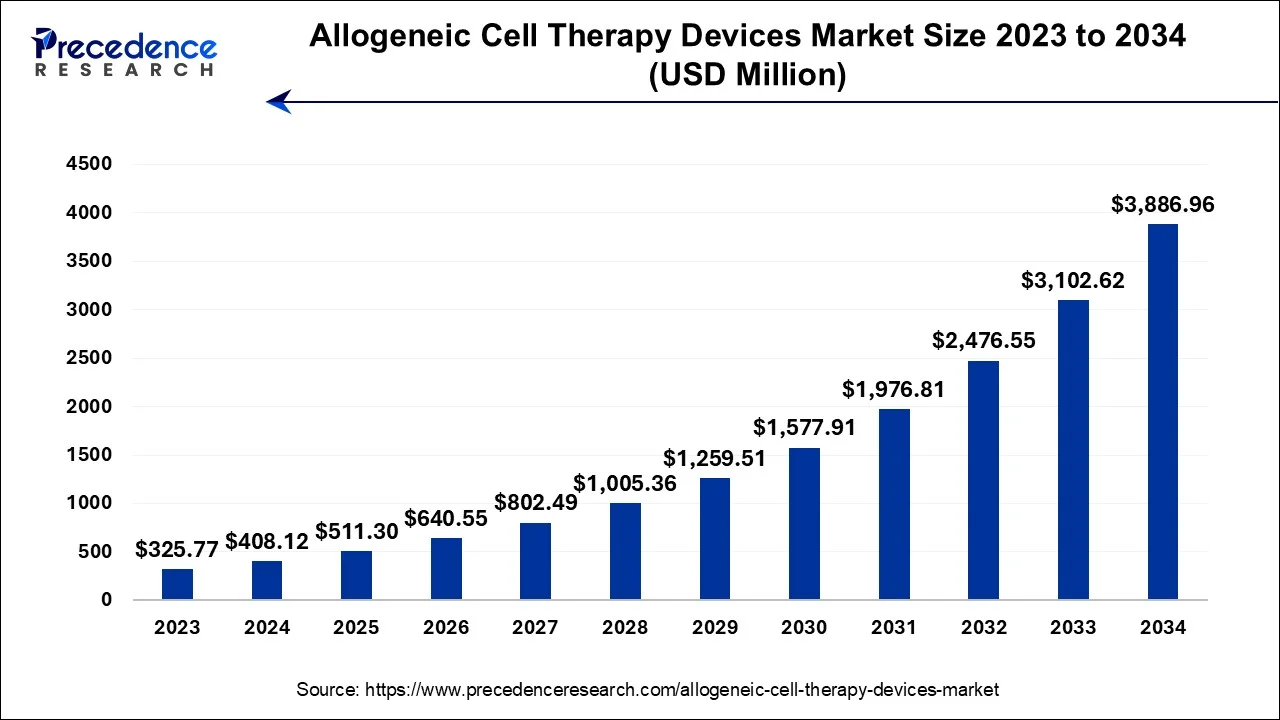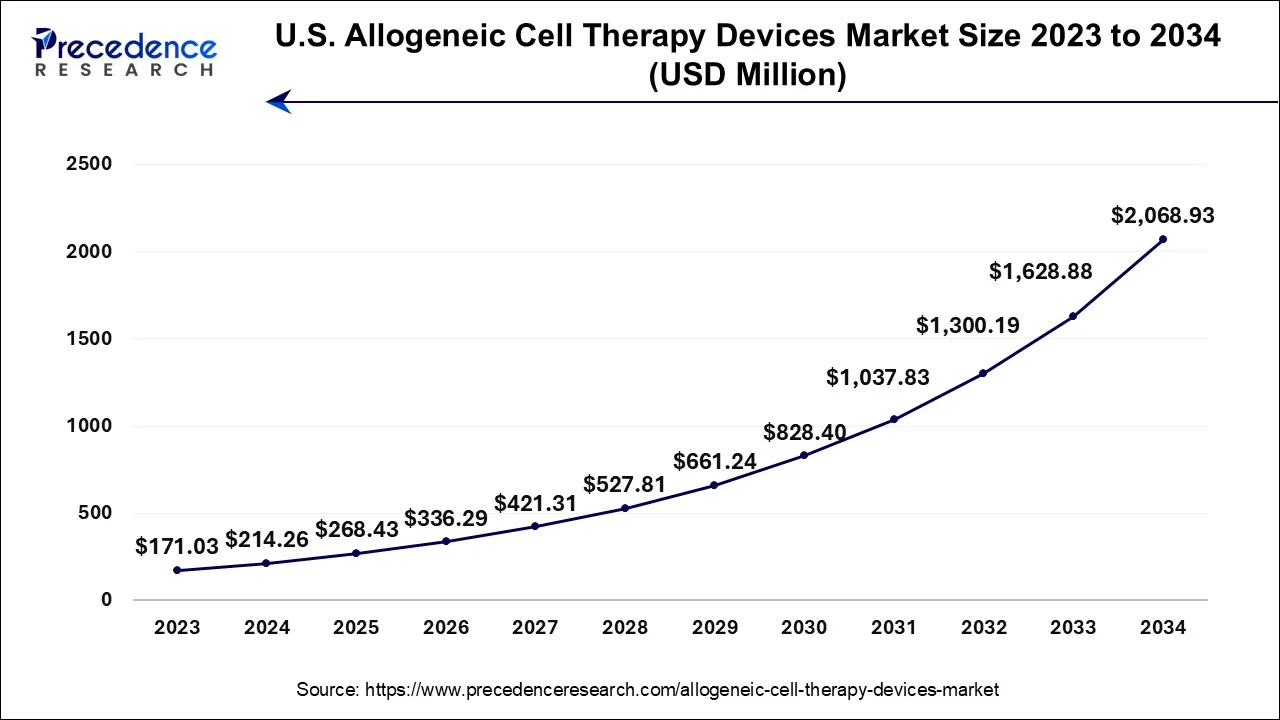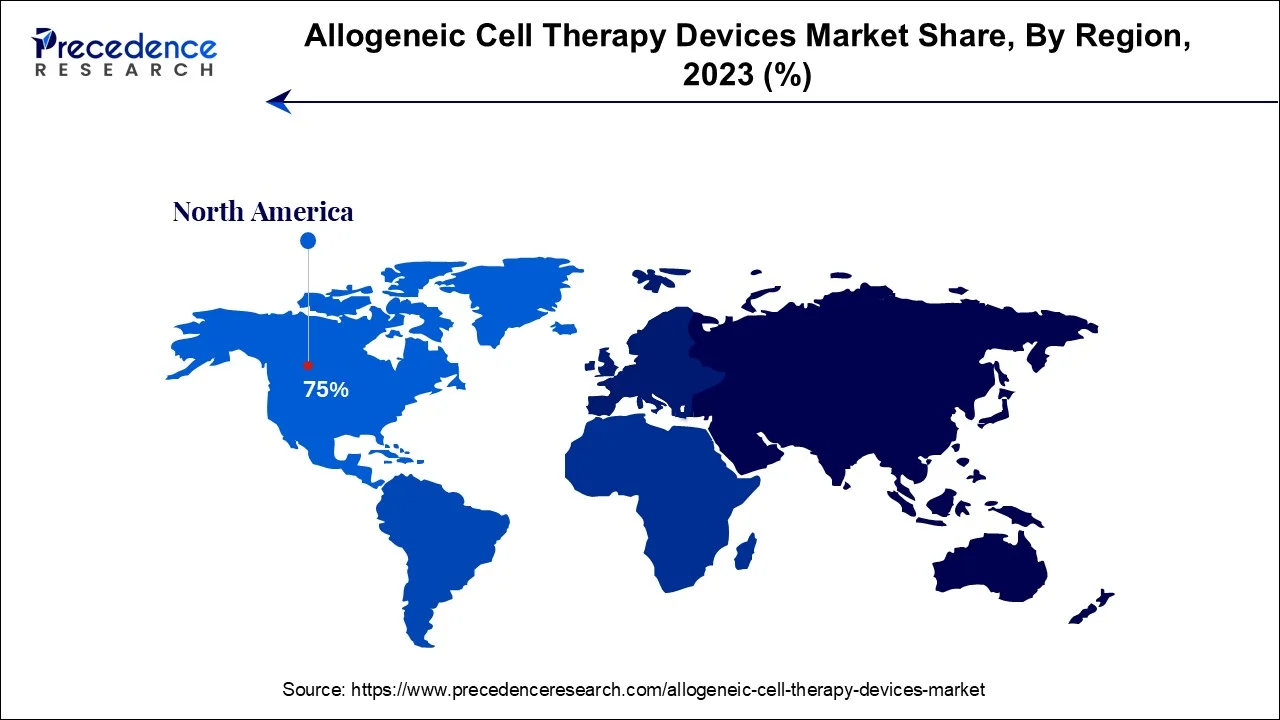February 2025
The global allogeneic cell therapy devices market size is estimated at USD 408.12 million in 2024, grew to USD 511.30 million in 2025 and is predicted to surpass around USD 3,886.96 million by 2034, expanding at a CAGR of 25.28% between 2024 and 2034.
The global allogeneic cell therapy devices market size accounted for USD 408.12 million in 2024 and is anticipated to reach around USD 3,886.96 million by 2034, expanding at a CAGR of 25.28% between 2024 and 2034.

The U.S. allogeneic cell therapy devices market size is estimated at USD 214.26 million in 2024 and is expected to be worth around USD 2,068.93 million by 2034, growing at a CAGR of 25.45% from 2024 to 2034.

North America as held largest revenue share in allogeneic cell therapy devices in 2023. North America boasts consist one of world's most advanced healthcare infrastructures, including specialized hospitals, innovative research facilities, and well-developed regulatory frameworks. These factors provide a beneficial environment for the commercialization and development of allogeneic cell therapy devices across the region.
Asia-Pacific estimated to observe the fastest expansion in the allogeneic cell therapy devices market in 2022. This is because various countries in the Asia-Pacific region have been investing significantly in upgrading their healthcare infrastructure, including the development of cutting-edge research facilities and specialized treatment centers. This infrastructure supports the advancement of allogeneic cell therapies. Moreover, the region continues to invest in healthcare infrastructure and innovation, it is well-positioned to play a vital role in the future of allogeneic cell therapy devices across the Asia-Pacific region.

The European allogeneic cell therapy devices market is anticipated to grow at a high rate during the forecast period. This is due to the Europe's commitment to research, innovation, and regulatory support positions it as a key region for high growth in the allogeneic cell therapy devices market. As the field continues to advance, Europe is likely to play a pivotal role in shaping the future of cell therapy development and adoption.
The allogeneic cell therapy devices is a dynamic sector within the healthcare and biotechnology industries that includes manufacturing, development, and application of specific devices and technologies vital for allogeneic cell therapy. It comprise using donor-derived cells to treat various medical conditions, from cancer to autoimmune diseases.
The allogeneic cell therapy devices market involves a comprehensive array of equipment, including purification devices, bioreactors, cell culture systems, and cryopreservation tools, which are essential for the administration and production of these therapies.
The allogeneic cell therapy devices market significance lies in its impact to evolving the field of regenerative medicine by providing the infrastructure vital to harness the therapeutic potential of allogeneic cell therapies. Manufacturers within the market engage in research, development, and commercialization of these devices, addressing critical aspects such as scalability, quality control, and safety.
How AI is changing the allogeneic cell therapy devices market?
Implementation of AI in the allogeneic cell therapy devices market has the potential to revolutionize the cell therapy technique by allowing researchers to analyze vast amounts of data and develop new insights into how cells work. The major impact of AI will be to develop the ability to help identify the suitable cells for a particular patient. This can be achieved by analysing patient history and clinical background using AI algorithms so an effective treatment can be predicted. AI can also help researchers determine the optimal growing condition of cells. AI has the ability to accelerate and enhance regenerative medicine research and development. The integration of AI is expected to be a useful tool for researchers and practitioners to grow in the field of medicine, pharmaceuticals, and healthcare. AI will also leverage various processes such as drug development, medical treatment, and disease diagnosis.
| Report Coverage | Details |
| Growth Rate from 2024 to 2034 | CAGR of 25.28% |
| Market Size in 2024 | USD 408.12 Million |
| Market Size by 2034 | USD 3,886.96 Million |
| Largest Market | North America |
| Base Year | 2023 |
| Forecast Period | 2024 to 2034 |
| Segments Covered | Therapy Type, Therapeutic Area, and Region |
| Regions Covered | North America, Europe, Asia-Pacific, Latin America, and Middle East & Africa |
Increasing incidence of chronic diseases
Chronic diseases, such as cardiovascular diseases, diabetes, cancer, and neurodegenerative disorders, are striking a significant and rising burden on global healthcare systems. Allogeneic cell therapy delivers an approach to address these challenging conditions. Traditional treatment modalities often provide only symptomatic relief or temporary management, leaving a significant unmet medical need. Allogeneic cell therapies, derived from healthy donor cells, have the potential to target the root causes of these diseases, providing curative or disease-modifying effects.
Furthermore, healthcare providers and patients both are seeking advanced, innovative and additional effective treatment options. This growing demand is catalyzing investments in research and development, clinical trials, and manufacturing capabilities for allogeneic cell therapies. Moreover, regulatory agencies are recognizing the promise of these therapies, streamlining approval processes, and facilitating market entry.
For instance, in December 2022, BioCardia received approval for its stem cell implants designed to help rescue patients from heart failure from the FDA. According to the company, it offers a complete cell therapy solution for ischemic heart failure patients that involves both off the shelf and autologous allogeneic cell therapies. Thus, the increasing incidence of chronic diseases underscores the urgent need for transformative treatments, positioning the allogeneic cell therapy devices market as a pivotal player in the healthcare landscape.
High development costs
The intricate and multifaceted nature of developing allogeneic cell therapies, from research and preclinical studies to clinical trials and commercialization, incurs substantial expenses. These costs may act as a deterrent to both emerging biotech firms and established pharmaceutical companies, restraining their capability to invest in and improve these therapies. In addition, the need for state-of-the-art facilities and equipment for cell culture, expansion, and manipulation is one of major cost driver, all of which require substantial capital investment. In addition, the recruitment and retention of specialized talent in the fields of cell biology, immunology, and bioprocessing further inflate operating costs.
Furthermore, the rigorous regulatory requirements imposed by health authorities, such as the FDA and EMA, necessitate extensive preclinical testing and rigorous clinical trials. These studies are not only resource-intensive but also time-consuming, delaying potential market entry and accruing additional costs. Moreover, manufacturing processes for allogeneic cell therapies must be developed with meticulous attention to quality control and consistency, further adding to expenses.
The need to establish robust supply chains, infrastructure, and logistics for the collection, processing, and distribution of donor cells also contributes to the financial burden. Thus, the formidable development costs associated with allogeneic cell therapy devices can inhibit market growth and accessibility. Finding innovative ways to reduce these costs, such as optimizing manufacturing processes or leveraging economies of scale, will be crucial to realizing the full potential of allogeneic cell therapies and making them more accessible to patients in need.
Rising government activities for improving healthcare insurance frameworks
Government strategies to improve healthcare affordability and accessibility are forming a favorable environment for the adoption of advanced medical treatments, including allogeneic cell therapies. Globally governments are gradually identifying innovative therapies to advance patient outcomes and decrease the long-term economic burden of chronic diseases. Therefore, various manufacturers are taking steps to incorporate these therapies into their healthcare insurance frameworks. This may include reimbursement policies and coverage expansions, making these innovative treatments more accessible to a broader patient population.
Furthermore, governments are investing in research and development, boosting partnerships with pharmaceutical companies and academic institutions to accelerate the development of allogeneic cell therapies. These collaborations may lead to the formation of further effective therapies and facilitate their market entry. Improved insurance frameworks also reduce the financial burden on patients, making allogeneic cell therapies a viable option for individuals who may not have been able to afford them otherwise. This broader patient access not only benefits the individuals but also fosters market growth and innovation as demand for these therapies increases. Thus, the alignment of government activities with the advancement of healthcare insurance frameworks is creating significant growth opportunities for the allogeneic cell therapy devices market.
Impact of COVID-19
The COVID-19 pandemic has had both positive and negative impacts on the allogeneic cell therapy devices market. Initially, the pandemic disrupted the healthcare industry as resources and attention were redirected toward combating the virus. This led to delays in clinical trials, reduced patient access to therapies, and supply chain disruptions, affecting the allogeneic cell therapy market negatively. However, several factors have also created opportunities for the market during the pandemic.
The focus on the development of vaccines and treatments for COVID-19 accelerated research in areas such as immunology and cell therapy, potentially benefiting allogeneic cell therapies in the long run. Moreover, the pandemic highlighted the need for innovative and resilient healthcare solutions, making the market more attractive to investors.
Furthermore, telemedicine and remote monitoring also gained prominence during the pandemic, creating a conducive environment for the adoption of allogeneic cell therapies, which often require ongoing patient monitoring and follow-up. In addition, governments and regulatory agencies recognized the importance of advanced therapies in pandemic preparedness and response, potentially leading to streamlined regulatory pathways and increased funding for cell therapy research. Thus, the COVID-19 pandemic initially disrupted the allogeneic cell therapy devices market, but it has also underscored the importance of innovative healthcare solutions, potentially driving future growth and innovation in the field.
According to the therapy type, the stem cell therapy type has held highest revenue share in 2023. This segment includes treatments that utilize stem cells, which have the unique ability to differentiate into various cell types. The dominance of the stem cell therapies segment in the allogeneic cell therapy devices market is due to the surging occurrence of target diseases that can be cured with such therapies. It primarily treats chronic diseases such as leukemia, lymphoma, blood cancers, and specified blood or autoimmune disorders.
The non-stem cell therapy type is anticipated to expand at a significantly CAGR during the projected period. This segment includes cell-based therapies that do not rely on stem cells. It includes treatments using differentiated cells or immune cells, such as T-cell therapies, dendritic cell therapies, islet cell transplantation, and chondrocyte therapies.
Based on the therapeutic area, the hematological disorders segment is anticipated to hold the largest market share in 2023. The incidence of hematological disorders continues to rise globally, necessitating more advanced and effective treatment options. This growing patient population contributes to the segment's market share. Moreover, hematological disorders, including leukemia and lymphoma, have a long history of being treated with allogeneic cell therapies, particularly hematopoietic stem cell transplantation (HSCT). These treatments have demonstrated effectiveness in replacing diseased or damaged blood cells with healthy donor cells.
On the other hand, the dermatological disorders is projected to grow at the fastest rate over the projected period. This is due to the surging awareness of allogeneic stem cell-based therapy products used to treat a various dermatological diseases such as, wound healing, skin aging, scar therapy, atopic dermatitis, autoimmune skin disorders, and others.
Segments Covered in the Report
By Therapy Type
By Therapeutic Area
By Geography
For inquiries regarding discounts, bulk purchases, or customization requests, please contact us at sales@precedenceresearch.com
No cookie-cutter, only authentic analysis – take the 1st step to become a Precedence Research client
February 2025
January 2025
January 2025
January 2025